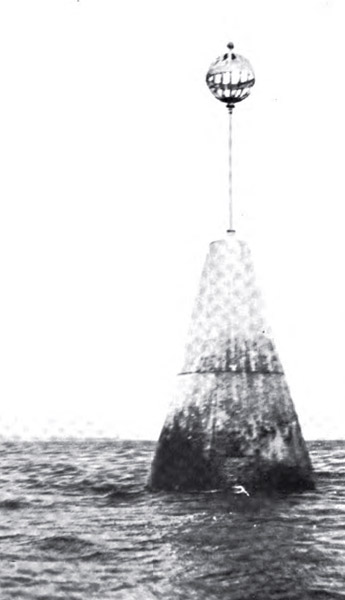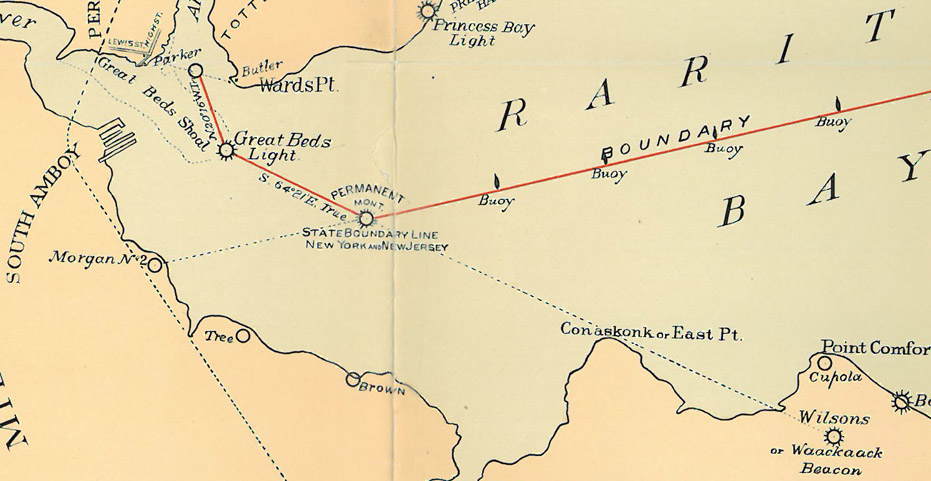Morgan Maps – The Monument and Buoys
One result of the decisions of the 1887 Joint Boundary Commission (see to-be-reposted write-up), which defined the still in effect state boundary lines across and under Raritan Bay between the states of New Jersey and New York, was something called “The Monument”.
At the time of the commission it was common practice to place inscribed granite monuments at key points along the NJ/NY boundary to mark the boundary. Naturally putting a solid granite monument on water was not possible and required a different approach. They needed something which would float. At the eleventh meeting of the Joint Boundary Commission held on October 31, 1887 at 47 Montgomery Street, Jersey City, NJ, the commissioners decided “to use iron for casing the permanent monument.”
At the following (12th) meeting on November 30, 1887, Lieut. G. C. Hanus (US Navy representing New York) indicated to the commission “… the position of the permanent beacon has been properly located on the ground… It is marked by five stakes, the center one having a red flag nailed to it. As the position is very important, I subsequently planted a second-class wooden spar-buoy on this spot, with the aid of the light-house tender. It is not likely that the ice will carry this buoy away, as it is well moored to a heavy stone anchor.”

The “Monument” Marking the Boundary Line Between New Jersey and New York on Raritan Bay, Circa 1919.
You can see the position of “The Monument” on the map at the spot where it says “Permanent Mont.”
At this same meeting, regarding the buoys which were also to be placed on the boundary line defined by “Morgan 2” and the Romer Stone Beacon, Lieut. Hanus indicated “Through the kindness of the Light-House Board, I was enabled to plant all the buoys without much difficulty… we had no difficulty in dropping the buoys in the desired places on the boundary line. The buoy nearest the monument was placed in the position marked on the map. It is a second-class wooden buoy.” The next four buoys were “iron spar-buoy of the third class…All the above buoys are painted white above the line of floatation and green under water” and the seventh buoy was a “wooden can, and can be replaced by an iron spar.”
The permanent “monument” was eventually put in the bay at the intersection of the Great Beds/Waackaack Beacon line and the “Morgan 2”/Romer Stone Beacon line where it remains today. In the days before electronic navigation, this monument provided a visual reference point to navigators and was especially necessary since the boundary line changed direction at this point. Great Beds Lighthouse served a similar function as the boundary also changed direction at that spot.
Putting a “Permanent Mont.”, i.e., PermanentMonument, on water required a different approach though it still was to have “State Boundary Line, New York and New Jersey” engraved on it.
This photo shows what “The Monument” looked like circa 1919. It was to have “State Boundary Line, New York and New Jersey” inscribed on it. I’m hoping to one day get an updated photo of what is located at this site from someone who still boats about in Raritan Bay. I don’t recall seeing the globe on the monument and doubt that the globe would still be on it well over a century after the monument was put in place.
As a kid, when we went boating in the bay I knew of “The Monument” but really didn’t have any clue as to its significance or usage. I doubt anyone else knew much about it either at the time or, perhaps, even now. Hopefully this posting will make this clear.
Originally posted on March 21, 2010.

The Monument, also known as the Boundary Light, is no longer in existence. It was dynamited sometime in the 1970’s I believe. I remember it as a teen in the 60’s. At that time it was just the masonary cone with no light on it.
The monument, or Boundary Light , was removed sometime in the ’70’s.